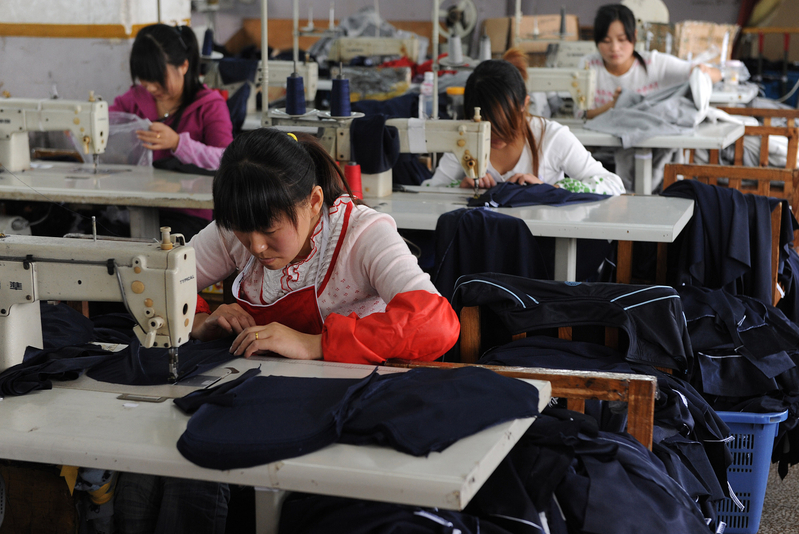[Epoch Times, August 26, 2021]The epidemic and rising raw material prices have caused a labor shortage in mainland factories. Foreign media said that labor shortages in various parts of the mainland are frequent. From this, it may be possible to see the greater challenges that China will face in the future as the working population is aging and shrinking.
The Wall Street Journal reported on August 26 that since the beginning of this year, overseas markets have seen a surge in demand for various Chinese products such as handbags and cosmetics, and the owners of these products have expressed that they have encountered difficulties in recruiting workers.
Some migrant workers worry about getting the virus in the city or in the factory. Other young people are reluctant to be workers, but tend to work in service industries with higher pay or lower intensity.
Yan Zhiqiao, who runs a cosmetics factory in Guangzhou, said it is difficult to recruit and retain employees this year, especially those under the age of 40. There are about 50 workers in the factory.
Yan said the factory was unable to raise wages, mainly because of the increase in raw material prices this year.
Li Peng, secretary-general of the Asian Footwear Association in Dongguan, said that as the epidemic has swept other Asian countries and buyers have moved their businesses from other places, orders from some mainland factories have soared. He said that this makes some companies more eager to recruit employees through salary increases.
Li Peng said that many factory owners are now in a dilemma. They don’t know if they can make a profit if they accept new orders. He said that the biggest headache for these factory owners is the difficulty of recruiting workers.
Guangdong has always been a major province with the influx of migrant workers. In May of this year, the mainland media reported that the recruitment market in Guangdong this year was declining. Many technical jobs cost 700 yuan a day, and it is still difficult to find a job. Even because of the difficulty in hiring, there was a rare scene where the boss was holding a “signboard” and standing on the street waiting to be “selected” by the workers.
While there is a shortage of factory labor, another area of the Chinese economy is facing the opposite challenge: there are too many white-collar professionals. Economists say that there are more than 9 million college graduates this year, a record high, which will exacerbate the structural mismatch in China’s labor market.
The decline in the number of manufacturing workers has forced many factories to pay bonuses or raise wages, eroding profit margins that are already under pressure from rising raw material and logistics prices.
Lu Media reported that the root cause of the labor shortage is the shortage of labor. Not only is the recruitment of textile factories tight, but the recruitment of other factories is not easy. The current degree of aging in mainland China is relatively high, and there are relatively few young people. The most important thing is that Young people still lack the willingness to give birth, so the labor force can be said to have entered an era of unavailability, and there is a shortage of labor everywhere.
According to China’s 10-year census, the working-age population aged 15 to 59 will fall to 894 million in 2020, accounting for 63% of the total domestic population; in 2010, the working-age population in China was 939 million, accounting for 70% of the total population at that time .
According to official estimates, China’s working-age population will decrease by about 35 million during the “14th Five-Year Plan” period.
According to data from the National Bureau of Statistics of the Communist Party of China, in 2020, the total number of migrant workers fell for the first time in 10 years, reducing by more than 5 million to 285.6 million.
Jeroen Herms, co-founder of BSK Fashion Bags, said that after the traditional Chinese New Year in February this year, nearly one-third of the company’s more than 100 factory employees in Guangzhou did not return to work, which is higher than the previous 20%.
“We can hardly recruit workers because many people don’t leave their hometowns anymore. The new crown epidemic has accelerated this trend,” Herms said. He is Dutch and founded this handbag factory in 2011.
He said that the average age of workers has risen from about 28 years ago to at least 35 years ago. In order to expand production, the company plans to build a new factory in Henan Province, which is the main source of migrant workers. The company will also increase investment in automation.
The factory owner said that many people are worried about the epidemic in larger cities and they no longer return to work in the factory.
In addition, the annual survey of migrant workers by the National Bureau of Statistics of the Communist Party of China shows that more and more young people regard factory work as a chore.
Foreign media reported that the problems in the mainland also reflect longer-term demographic changes, including the shrinking workforce. These changes are the result of China’s one-child policy that has been implemented for decades.
Ding Shuang, an economist at Standard Chartered Bank in Hong Kong, said China’s demographic dividend has long been exhausted.
Editor in charge: Fang Xiao#
.
